Understanding SI2 Clarity Grade
How to potentially save big with an SI2 clarity diamond
How to potentially save big with an SI2 clarity diamond
An SI2 (Slightly Included) clarity grade is on the lower, but still acceptable, end of the diamond clarity scale. SI2 diamonds offer excellent value, with inclusions that are often not visible to the naked eye but are noticeable to a diamond grader under 10x magnification. However, it’s important to note that not all SI2 diamonds are the same, and some may have more noticeable inclusions. If you can find an SI2 diamond that is eye-clean, you can save significantly compared to higher clarity grades. Prices for an SI2 diamond can range from around $2,400 to $3,500 for a 1 carat diamond, depending on other factors such as cut, color, and carat weight.
When shopping for an SI2 diamond, it is important to look for an eye-clean diamond. Inspect the diamond certificate clarity plot to understand the types and locations of the inclusions. Look for inclusions that can be easily covered by the ring setting or prongs.
What are SI2 diamonds?
What is the difference between SI2 and SI1 diamonds?
What is the difference between SI2 and VS2 diamonds?
SI2 diamonds on the diamond clarity scale
Should I focus on SI2 clarity when buying a diamond?
Are SI2 diamonds eye-clean?
What tips should I follow to get a beautiful SI2 clarity diamond?
Where is the best place to buy an SI2 clarity diamond?
FAQs
Buying an SI2 clarity diamond is an opportunity to find some incredible value. As we will discuss below, as long as a diamond is eye-clean, there is no need to spend more on a diamond’s clarity.
Here is a lovely SI1 clarity diamond from James Allen that we would recommend which is $3,960. But if you were looking for better value, this SI2 clarity diamond from James Allen should be eye-clean and you can save 25%. But if you go too far, you may end up with an SI2 like this one. True it saves you 37%, but it’s horrific looking and not worth spending any money on.
A diamond that’s graded an SI2 will undoubtedly have inclusions. Sometimes those imperfections will be visible to the naked eye, and sometimes they can only be seen under magnification.
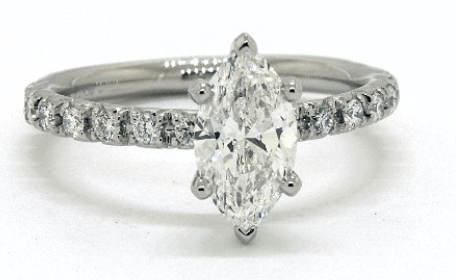
Why you should trust us
We estimate that about 70% of SI2 diamonds will not be eye-clean. That’s why the goal is to find one of the 30% of SI2s that indeed are eye-clean.
With an eye-clean SI2 diamond, you can save hundreds or thousands of dollars instead of paying for a better clarity grade. While you can get incredible value with an SI2 diamond, you have to be extra careful to choose one that’s eye-clean.
The GIA lab (the world’s pre-eminent diamond grading lab defines SI2 diamonds as “slightly included to the 2nd degree, meaning they have inclusions that are easily seen under 10X magnification”. Some SI2 diamonds are eye-clean. A larger portion, however—approximately 70% to 95% (depending on the size of the diamond)—are not eye-clean. That’s why you need to carefully examine SI2 diamonds.
If you can find an eye-clean SI2 diamond, you’ll get the biggest bang for your buck. Instead of paying for a higher clarity grade, you spend much less while still getting an eye-clean stone. This is more challenging with SI2 diamonds, but it’s still possible.
SI2 diamonds have more noticeable inclusions than SI1 diamonds. An SI2’s imperfections also tend to be darker or more obvious. That’s why more SI1 diamonds are eye-clean. In general, SI1 diamonds will be the best value for an eye-clean stone in most diamond shapes. Sometimes, though, you can find an eye-clean SI2 diamond—saving you hundreds over an SI1 diamond. For example, this eye-clean SI2 Marquise diamond from James Allen costs $1,410, while this SI1 Marquise diamond costs $1,560. That’s a 16% difference. The price jump from SI1 to SI2 is significant, and that’s for good reason. There are more SI1 eye-clean stones, while SI2s tend to have more noticeable flaws.
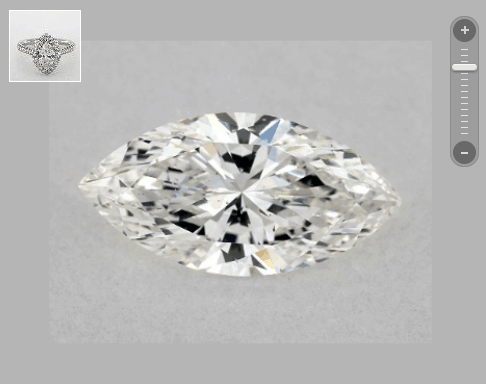
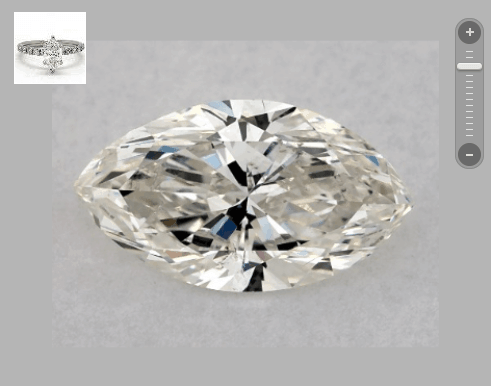
If you cannot find an eye-clean SI2 diamond, the extra cost for SI1 clarity is worth it. Having a diamond with noticeable blemishes detracts from its beauty. It’ll be something you notice for the life of the engagement ring. That’s why it’s important to look closely at each diamond to make sure that you can’t see imperfections.
The difference between SI2 clarity and VS2 is just two steps on the diamond clarity chart. However, the true difference between SI2 and VS clarity is immense, as most VS2 (or VS1) diamonds can be expected to pass as eye-clean.
The gap between an SI2 and VS2 is also reflected in pricing, as a VS2 clarity diamond can be more than two times the price of an SI2, with all other grades being equal.
Take these two 1 carat, J color round diamonds as an example. The first, SI2 clarity, is $4,730. While a similar diamond with a VS2 clarity grade will cost you $5,320.
This massive difference in cost means you can save a lot by picking out a diamond with an SI2 clarity grade. But it’s only worth it if you are able to find an SI2 diamond that is truly eye-clean and free from obvious imperfections.

To understand what you’re looking at with an SI2 clarity diamond, you first need to know where it stacks up on the diamond clarity grading scale.
Every diamond should come with a lab certificate. We only recommend a GIA certificate because they’re the most reliable lab entities.
The GIA grades clarity from best to worst:
When diamonds are formed, their structures pick up small imperfections along the way. A diamond’s clarity grade depends on the size, type and location of the imperfections. In general, diamonds with more inclusions, bigger inclusions and darker inclusions will have a lower grade. A gemologist looks at the diamond under magnification from all angles to determine the grading.
Every diamond has imperfections, so it’s a matter of whether you can see them.
SI2 diamond clarity can be a smart purchase, depending on if the diamond is eye-clean. All diamonds have imperfections due to their formation beneath the earth’s surface. Your goal is to find out if the inclusions are visible. SI2 diamonds tend to have more imperfections and more noticeable inclusions than better grades, such as SI1 or VS2 clarity, but sometimes you can find an eye-clean stone. If you can find an eye-clean SI2 diamond, you’ll get the most for your budget.
You can spend a lot of time stressing over clarity grades, but a diamond’s actual appearance is the only thing that matters. Not all SI2 diamonds are the same—some are beautiful and some have glaring blemishes.
Instead of focusing on whether a diamond has a certain clarity grade, look for one that is eye-clean. We use the term “eye-clean diamond” when a diamond looks clear and free of imperfections to the naked eye.
Experts may be able to see inclusions using a magnifying glass, a microscope, or a loupe, but it’s more important that a typical person can’t see anything under normal viewing conditions.
While approximately 70% of SI2 diamonds are not eye-clean, you may still be able to find a beautiful SI2 diamond where any inclusions it has are easily hidden or in positions where they are difficult to notice.
We recommend finding the cheapest (in regards to clarity; other factors matter as well, such as diamond color and cut quality) eye-clean diamond you can. This will allow you to get the best value possible, as you’ll avoid overspending on a clarity grade that is too high.
Sifting through hundreds of diamonds and assessing each one for clarity is an arduous task, which is why we developed Ringo.
Ringo is a patented artificial intelligence model, designed to examine videos of diamonds to tell whether or not they are eye-clean. Ringo can also filter for other parameters, such as making sure the diamond is well-cut, that there are no issues with fluorescence, and that it matches the style setting you choose.
If you want to select a diamond specifically for your personal needs (budget, shape and setting style), check it out here.
When it comes to evaluating the clarity of a diamond, there are a few tips to keep in mind. For SI2s specifically, here’s what to watch for.
It’s impossible to know if an SI2 diamond is eye-clean without looking at it closely. With high-tech imagery and HD video, you can look at the diamond from all angles. If you can’t tell if a diamond is eye-clean, ask an expert to give you their opinion.
With a GIA certificate, you’ll usually see a clarity plot—at least for diamonds over 1 carat. The clarity plot is a map of all of the inclusions in the diamond. Knowing where the imperfections are will help you examine the stone. If an SI2 clarity diamond has a clean clarity plot, that’s a huge red flag and you should look for the reason for the SI2 grade (e.g. check out comments below diamonds specifications). All SI2 diamonds will have imperfections.
If inclusion is sitting on the edge of a diamond’s table, it’s likely to be covered by a ring setting or prong. At the least, it won’t be as noticeable as an inclusion that’s in the dead center of the diamond’s table. An SI2 diamond with imperfections near the edges is a great find for beauty—and your budget.
A clump of imperfections will be more obvious than spread-out inclusions. Aim for small inclusions scattered across the diamond’s table, because they won’t be as noticeable.
Some diamond shapes hide inclusions better than others. For round cut diamonds under 1 carat, you can sometimes find an SI2 without visible inclusions. If you’re going over 1 carat, you’ll want to look for an SI1 or VS2. That’s because the larger the diamond, the easier it is to see inclusions.
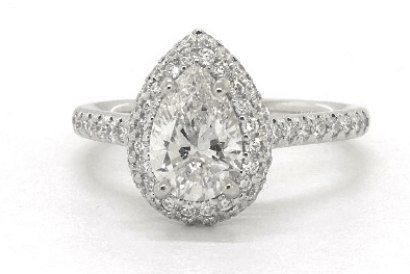
For oval cuts, cushion cuts, radiant cuts, marquise and pear shapes, you can more easily find an eye-clean SI2 because these shapes hide inclusions better than round diamonds. For emerald cuts, asscher cuts, princess cuts, baguettes and heart shapes, you’ll want to look for a VS2 (sometimes an SI1) for the best value. These shapes don’t hide inclusions as well, and it’s typically very challenging to find an eye-clean SI2 (if some inclusions are located in the corners of a princess cut, they can make a stone more prone to chipping).
GIA is the most consistent and reliable lab entity in the world. In other words, you can trust the SI2 designation when they give it out. If the certificate is from a less consistent lab, like the IGI, an SI2 diamond is likely to be more like an I1 or I2 clarity diamond. You can’t rely on the grading, which defeats the purpose of the certificate.
The number one aspect that impacts a diamond’s beauty is its cut quality. We recommend narrowing your search to only Excellent and Ideal cut diamonds. While you don’t want a diamond with an obvious imperfection, you should look for the lowest clarity grade that will give you an eye-clean stone. You’ll then be able to put more of your budget toward a beautifully cut or larger diamond. Read more in our guide to diamond cut.
A well-cut 1 carat round SI2 diamond with an I-K color will cost between $2,400-$3,500 from a reputable online vendor. Shopping in brick-and-mortar stores will be approximately 40% more expensive. A round cut SI2 diamond with I-K color would probably cost between $3,080-$4,760 in the store.
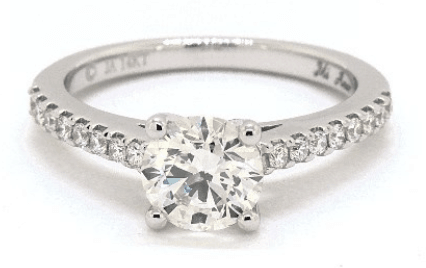
The price of a diamond depends on a variety of factors including cut quality, color, carat weight and clarity. In general, SI2 diamonds are less expensive than SI1 diamonds, but more expensive than I1 diamonds—if all other characteristics are the same.
Prices also depend on your diamond shape. In general, round cut diamonds are the most expensive shape per carat. Choosing an oval cut or cushion cut with SI2 clarity, for example, will save you a little bit over a round cut diamond.
As mentioned above, the best places to buy an SI2 diamond are online retailers with high-quality imagery. In particular, James Allen has the best 360-degree images you can find.
Aside from being significantly cheaper, James Allen and also offer a large inventory of loose diamonds, increasing the chances that you’ll be able to find a suitable eye-clean SI2 diamond that fits your style preference.
The high-quality imagery and virtual inspection tools available on these two sites are particularly crucial for assessing diamond clarity. They allow you to get a close look at any imperfections, so you can be sure the diamond you’re getting will look stunning and free from any major flaws.
SI1 is one grade higher on the diamond clarity scale than SI2, and thus an SI1 diamond has fewer (or less noticeable) imperfections. This makes it a better purchase unless you can find an eye-clean SI2 diamond (which is certainly possible).
Most SI2 diamonds have inclusions that are noticeable to the naked eye, under normal viewing conditions. There are exceptions though (roughly 15% of SI2 diamonds are eye-clean), and some settings may adequately hide SI2 diamond’s imperfections.
SI2 is, generally speaking, a low clarity grade. It sits at the lower end of the diamond clarity scale, though it is still possible to find beautiful SI2 diamonds that don’t have any easily visible imperfections.
Some (but not all) SI2 diamonds have cloudy inclusions. A diamond appearing cloudy is just one type of inclusion, though it is certainly more common in lower clarity grades.
A nice one carat round diamond that is SI2 clarity costs about $3,400. The price can vary a bit based on which shape you select, what color grade you go with, and whether it’s well cut or not.
It can be a great value to find an SI2 diamond if it’s eye-clean. Because the price drops from SI1 to SI2, you can save a good chunk of money this way. With the savings on clarity, you’ll be able to put more of your budget into cut quality (the most important aspect).
You need to be extra cautious, however, with SI2 diamonds. The majority are not eye-clean, and therefore, not a good buy. Never buy an SI2 diamond blind; you should always inspect it to ensure the diamond’s inclusions are not overwhelming, and that it will appear clean to the naked eye.
Take your time or get expert help to find a beautiful SI2 diamond. Our experts are on hand to advise you during your search and help you pick out the perfect eye-clean diamond for your budget.




Before you buy a diamond, get personal buying advice from industry veterans. We'll help you get the best diamond for the money.
DISCLAIMER: We don't use your email for marketing. Period.
Please enter your email address to receive your 25% off coupon code:
Here is your coupon code: GFDSF3GF